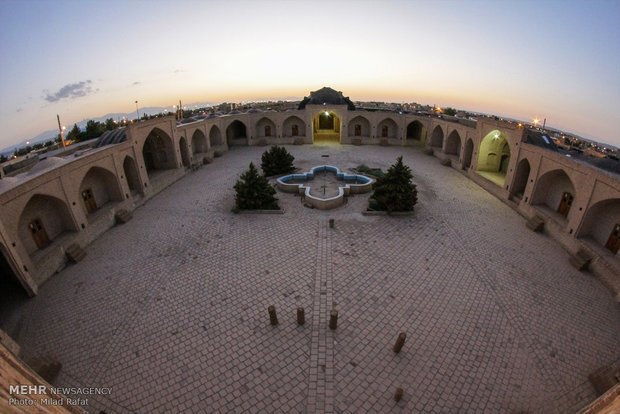A new round of restoration work has been commenced on the Safavid era (1501-1736) Shah Abbasi caravanserai in the north-central province of Semnan, the provincial tourism chief has announced.

The project involves replacing worn-out materials, cleaning the brick walls, and removing the layers of paint and grease from the stone and brick surfaces as well as removing extensions of the last few years, Hamidreza Dustmohammadi said on Thursday.
Strengthening the walls and repairing the historical inn’s façade are also parts of the project, the official added, ISNA reported.
The project is being carried out under the supervision of cultural heritage experts and by the order of Cultural Heritage, Tourism, and Handicrafts Minister Ezzatollah Zarghami, he noted.
Back in February, the historical inn was finally handed over to Semnan’s municipality after being used as a prison for over 40 years.
The Shah Abbasi caravanserai, which was inscribed on the National Heritage list in 1973, is planned to be repurposed to a cultural center after being fully restored.
The monument was set free after the demolition of the surrounding fences and high walls, which was took place after obtaining the necessary permits and transferring inmates to a new prison.
The mud-brick structure is named after Shah Abbas the Great (r. 1588 – 1629), who ordered the construction of such roadside inns across the country.
In August 2021, former Cultural Heritage, Tourism, and Handicrafts Minister Ali-Asghar Mounesan announced that Semnan municipality was ready to purchase the historical monument and turn it into a tourist complex.
“Using a historical structure as a prison is not that interesting and turning it into a cultural center could boost tourism in the region and attract more travelers.”
The main population centers of Semnan province lie along the ancient Silk Road (and modern-day Imam Reza Expressway), linking Rey (Tehran) with Khorasan (Mashhad). While few visitors spend much time in the area, driving through you can easily seek out several well-preserved caravanserais (notably Dehnamak and Ahowan), cisterns (the Cafe Abenbar in Garmsar is a special treat), and ruined mud citadels (Padeh is lumpy but fascinating). The large, bustling cities of Semnan, Damghan, and Shahrud (Bastam) all have a small selection of historic buildings and Semnan has a fine old covered bazaar.
UNESCO tag
Iran has put forward a selection of 56 caravansaries as a candidate for a collective inclusion in UNESCO’S cultural heritage list.
In 2020, the tourism ministry announced that Iran is developing a dossier for a selection of its historical caravanserais for a possible inscription on the UNESCO World Heritage list. In this regard, cultural heritage experts are assessing such monuments that are scattered across the country to make a shortlist in terms of their architecture, historical and cultural values.
Caravansary (also Caravanserai or Caravansaray) is a building that served as the inn of the Orient, providing accommodation for commercial, pilgrim, postal, and especially official travelers.
According to Encyclopedia Iranica, from the number of surviving caravansaries and their sizes, it is clear that in Safavid and Qajar times there was a state architectural department that was specifically concerned with the construction of caravansaries and stations on the overland routes. Furthermore, in the cities, several caravansaries were erected as lodging houses, depots, and commercial offices in the vicinity of the bazaars.
A typical caravansary consists of a square or rectangular plan centered around a courtyard with only one entrance and arrangements for defense if necessary. Whether fortified or not, it at least provided security against beasts of prey and attacks by brigands.
Iran’s earliest caravanserais were built during the Achaemenid era (550 -330 BC). Centuries later, when Shah Abbas I assumed power from 1588 – to 1629, he ordered the construction of network caravanserais across the country.
Such roadside inns were originally built during various epochs along ancient caravan routes in the Muslim world to shelter people, their goods, and animals. The former Silk Roads may be the most famous example dotted by caravanserais.


